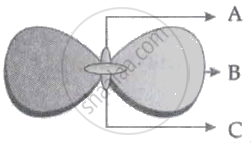Advertisements
Advertisements
Question
How is the equal genetic contribution of male and female parents ensured in the progeny?
Solution
In human beings, equal genetic contribution of male and female parents is ensured in the progeny through inheritance of equal number of chromosomes from both parents. There are 23 pairs of chromosomes All human chromosomes are not paired. Out of these 23 pairs, the first 22 pairs are known as autosomes and the remaining one pair is known as sex chromosomes, represented as X and Y. Females have a perfect pair of two X sex chromosomes and males have a mismatched pair of one X and one Y sex chromosome.
During the course of reproduction, as fertilization process takes place, the male gamete (haploid) fuses with the female gamete (haploid), resulting in the formation of the diploid zygote. The zygote in the progeny receive an equal contribution of genetic material from the parents. Out of 23 pairs of chromosomes in progeny, the male parent contributes 22 autosomes and one X or Y chromosome and the female parent contributes 22 autosomes and one X chromosome.
RELATED QUESTIONS
How do Mendel’s experiments show that the traits may be dominant or recessive?
In a monohybrid cross between tall pea plants (TT) and short pea plants (tt), a scientist obtained only tall pea plants (Tt) in the F1 generation. However, on selfing the F1 generation pea plants, he obtained both tall and short plants in F2 generation. On the basis of above observations with other angiosperms also, can the scientist arrive at a law? If yes, explain the law. If not, give justification for your answer.
Define heredity.
A Mendelian experiment consisted of breeding tall pea plants bearing violet flowers with short pea plants bearing white flowers. The progeny all bore violet flowers, but almost half of them were short. This suggests that the genetic make-up of the tall parent can be depicted as:
A Mendelian experiment consisted of breeding pea plants bearing violet flowers with pea plants bearing white flowers. What will be the result in F1 progeny?
What is the genotype of (i) dwarf plants, and (ii) tall plants, whose parental cross always produces tall offspring?
What are the units of heredity.
A cross between two individuals results in a ratio of 9 : 3 : 3 : 1 for four possible phenotypes of progeny. This is an example of a ______
In order to ensure that he had pure-breeding plants for his experiments, Mendel :
(a) cross-fertilised each variety with each other
(b) let each variety self fertilise for several generations
(c) removed the female parts of the plants
(d) removed the male parts of the plants.
In the human blood grouping, the four basic blood types are type A, type B, type AB, and type O. The blood proteins A and B are :
(a) simple dominant and recessive traits
(b) incomplete dominant traits
(c) codominant traits
(d) sex-linked traits
The term 'father of genetics' is used for the scientist :
(a) Morgan
(b) Mendel
(c) Darwin
(d) Marie Curie
The farmers have been cultivating a food plant X for over two thousand years and have produced as many as five entirely different looking vegetables A, B, C, D and E from it.
(a) What could the plant X be?
(b) What are A, B, C, D and E?
(c) What is the process of evolution involved in this example known as?
List two differences in tabular form between dominant trait and recessive traits. What percentage/proportion of the plants in the F2 generation/progeny were round, in Mendel's cross between round and wrinkled pea plants?
Explain the mechanism of hereditary changes.
What is genetics?
Who is the pioneer of modern genetics?
____________ refers to the transmission of genetic information from parental generation to next generation.
In humans, if gene B gives brown eyes and gene b gives blue eyes, what will be the colour of eyes of the persons having combinations
(i) Bb and (ii) BB?
If a tall pea plant is crossed with a pure dwarf pea plant then, what percentage of F1 and F2 generation respectively will be tall?
In the following figure showing a germinating gram seed, name the parts labelled as A, B and C:

Why is Part 'B' considered to be important during germination?
